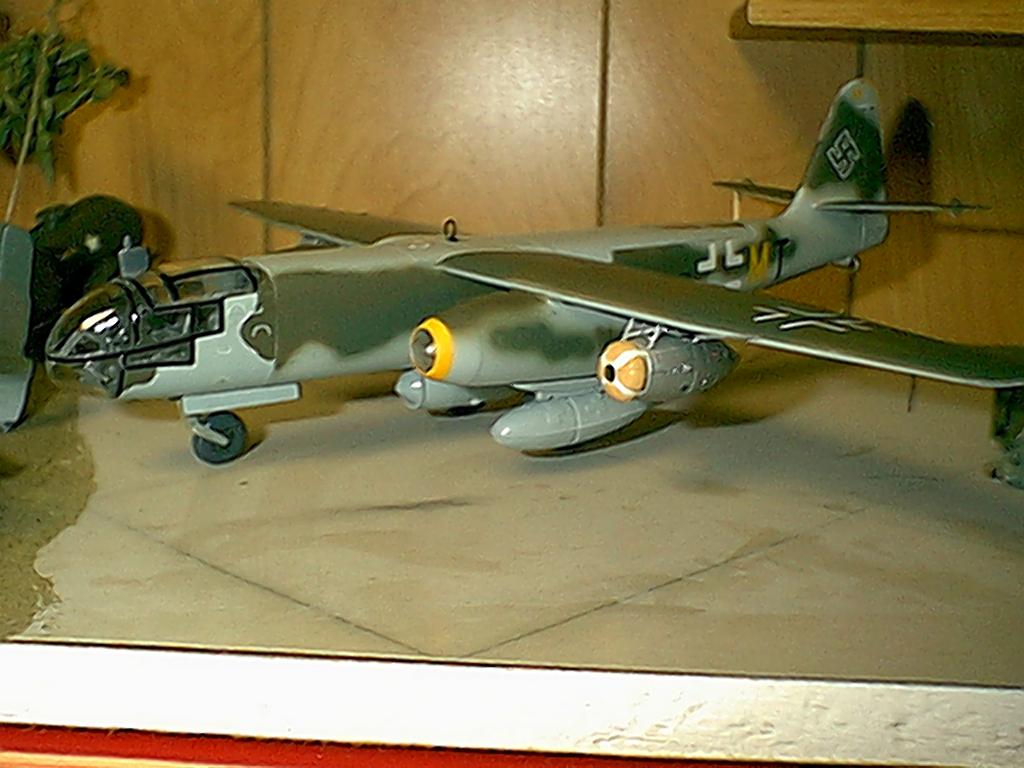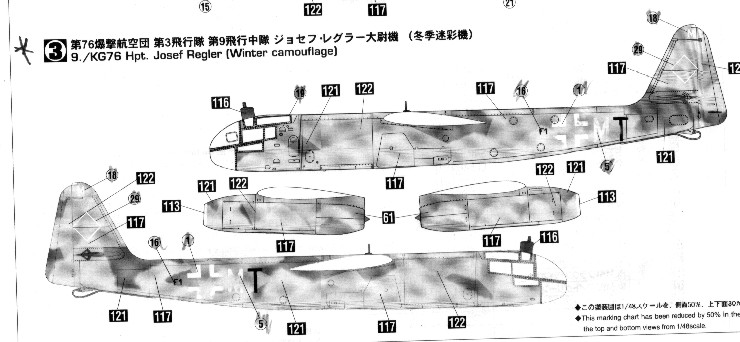Arado AR234B-2 Blitz Bomber
1/48 Scale, Hasegawa JT83 Kit
Start Build Date: 03/19/2003
Finished: 04/12/2003
Elapsed Building time = 24 days
160 Pieces

Colors:
All Paint were Model Master Acryl, Luftwaffe Late Camouflage:Licht Blau RLM76,
BraunViolett RLM81, DunkelGrun RLM82, 2 coats Future, Decals, Dullcoat,

Arado Ar234B-2, 9./KG76 Hpt. Josef Regler (Winter Camoflage)
Arudo Flugzeugwerke began development of jet propulsion systems in the autumn of 1940. Work was soon commenced on a twin-engined reconnaissance plane with the company code name E370/1V. Basic airframe arrangement consisted of long, straight-tapered wings with an engine under each wing set high in a long, cigar- shaped fuselage with a large transparent cockpit in the nose offering super. visibility for a single pilot Poor fuel economy of the plane's thirsty jet engines seat that an inordinate amount of fuselage interior space was taken up by fuel tanks negating the fuselage as a possible location for landing gear storage The wings, in addition, were too thin and delicate to accept landing gear. To get around this design dilemma. Arado came up with an innovative solution employing a releasable wheeled dolly for take-offs and sled runners for landing. Original design specs called for the airframe to be powered hy BMWP.3302 engines, hut this was changed to the Junkers Jumo 004 while the plane was still under development. Despite the switch to the more satisfactory Junkers Jumo powerplant, the airframe still suffered from a lack of overaI1 thrust during take-off. To rectify this problem, unnerving pylons for accepting Walther Ri-202 RATO (Rocket-Assisted Take-off) bottles were installed outboard of the engine pods. The Walther bottles were equipped with parachutes co they could be dropped and recovered after take-off for later re-use. A formal government contract for six prototypes was granted in April 1942, and the E370/IV was given the official Lightweight designation Ar234. The first prototype, Ar234VI fuselage code letters TG+KB), was completed on July 18th, 1943 and immediately sent up for a successful 14-minute maiden flight.
While the dolly/sled runner take-off/landing arrangement worked without a hitch
ie during testing, the Luttwaffe had doubts about the practicality of the system in
combat conditions, and demanded that Arado apply a tricycle landing gear
I- arrangement to the airframe for the next model, the Ar234B. The prototype for this
Model the Ar234V9 (fuselage code letters PH+SQ) made its flight in April 1944, but the fuel tank rearrangements necessary for the installation of the new
ie landing gear severely reduced fuel capacity, resulting in a commensurate loss in
.e operational range. Another result of the new landing gear installation, however, was
the opening up of space between the engine nacelle and fuselage as a potential location for bomb/ordnance stores. Luftwaffe policy makers quickly seized on this
opportunity and ordered the immediate development of a bomber version of the
aircraft, the Ar234B-2, postponing the pure recon version Ar234B-I until further
e notice. With the primary role for the Ar234 changed in mid-development and with
time of the essence, recon equipment. was left on the airframe as-is, giving the plane dual role capabilities When used in the recon role, the aircraft's nomenclature was
d Ar234B-2b. The Luftwaffe made an initial order of 20 planes, with the first plane of
0 the initial production hatch going making its maiden light on June 8th, 1944. A total
il of 210 aircraft were produced by war's end.
(Data)
Crev: one: length: 12.62m; wingspan: 14.4 lm: height: 4.28m; weight, fully-loaded:
8,675kg: engine: Junkers Jumo 004B (thrust = 900kgx2); top speed: 735km/h; operational range: l,600km; fixed armament: none: bomb load: up to l000kg

Would you like a scanned version of the instructions for this kit?, then email
Webmaster HERE
Ar234 Page
Return


